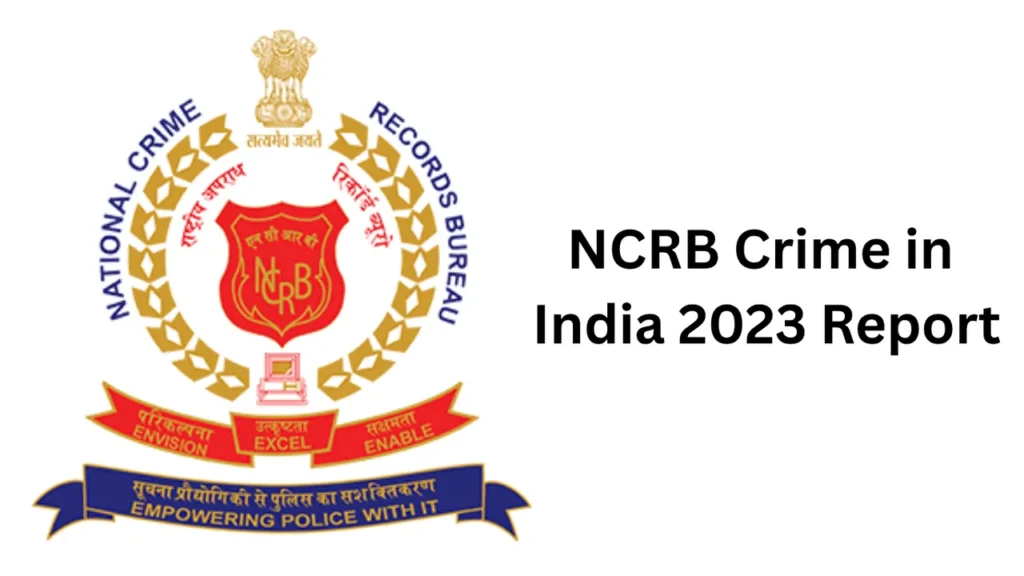New Delhi: In a revealing snapshot of India’s evolving criminal landscape, the National Crime Records Bureau (NCRB) has unveiled its “Crime in India 2023” report, highlighting a nation grappling with rapid digital transformation and persistent social challenges. Released under the auspices of the Ministry of Home Affairs (MHA), this comprehensive document paints a picture of rising overall criminal activities, with particular emphasis on exploding cyber threats, shifts in traditional offense patterns, and heightened risks to marginalized groups. As India transitions from the old Indian Penal Code (IPC) to the new Bharatiya Nyaya Sanhita (BNS) implemented in July 2024, 2023 stands as the final full year documented under the previous framework, offering critical insights for policymakers, law enforcement, and citizens alike.

Overall Crime Statistics: A Nation Facing Frequent Offenses
The report documents a total of 6.24 million cognizable crimes registered across India in 2023, representing a 7.2% increase from the previous year. This escalation translates to a crime rate of 448.3 per lakh population, up from 422.2 in 2022. Alarmingly, this means India experienced a criminal incident every five seconds throughout the year. Breaking down the figures, 3.76 million cases fell under the IPC, while 2.48 million were categorized under Special and Local Laws (SLL). This uptick underscores broader societal pressures, including urbanization and improved reporting mechanisms, which may contribute to the apparent rise in documented offenses.
Traditional violent crimes, such as rape and dowry-related deaths, have shown a welcome decline, signaling potential progress in awareness and enforcement. However, this positive shift is overshadowed by surging modern threats, particularly in cyber domains and urban environments. The data suggests a changing criminal paradigm, where digital vulnerabilities and city-based pressures are driving new forms of illegality.
Cybercrime Explosion: Fraud Dominates Digital Threats
One of the most concerning revelations is the 31.2% spike in cybercrimes, with 86,420 cases recorded in 2023 compared to 65,893 in 2022. The crime rate for this category jumped from 4.8% to 6.2%, reflecting the perils of India’s accelerating digitalization amid insufficient cyber hygiene practices. Fraud emerged as the predominant motive, accounting for 68.9% of incidents (59,526 cases), followed by sexual exploitation at 4.9% (4,199 cases) and extortion at 3.8% (3,326 cases).
This upward trajectory in cyber offenses has been consistent over recent years: starting from 27,248 cases in 2018, climbing to 44,735 in 2019, 50,035 in 2020, 52,974 in 2021, and 65,893 in 2022. Geographically, Karnataka reported the highest volume at 21,889 cases, including 18,166 instances of cheating through impersonation and 1,007 cases involving the transfer of obscene videos. Telangana followed with 18,236 cases, and Uttar Pradesh with 10,794. These statistics highlight the urgent need for nationwide cyber education, stronger digital infrastructure safeguards, and collaborative efforts between government and private sectors to combat online fraudsters exploiting India’s growing online population.
Urban Crime Pressures: Metropolitan Cities Bear the Brunt
Metropolitan areas witnessed a sharper 10.6% growth in crime rates, emphasizing the strains of urban living and possibly enhanced reporting systems. Delhi topped the list with the highest number of cases, serving as a microcosm of national trends where population density and economic opportunities intersect with criminal elements. This urban surge calls for targeted interventions, such as improved policing in high-density zones and community-based prevention programs to address root causes like migration and inequality.
Crimes Against Vulnerable Sections: Persistent and Emerging Challenges
The report delves deeply into offenses targeting marginalized groups, revealing mixed progress and stark concerns.
Crimes Against Women: Marginal Rise Amid Domestic Issues
Incidents against women increased by a slight 0.7%, totaling 4,48,211 cases. Domestic cruelty by husbands or relatives remained the leading category at 29.8%, underscoring enduring patriarchal structures and family-related tensions. Kidnapping and abduction followed at 19.8%, with sexual assault comprising 18.7%. These figures point to the need for stronger implementation of laws like the Protection of Women from Domestic Violence Act and broader societal shifts toward gender equality.
Atrocities Against Scheduled Castes and Tribes: Ethnic Conflicts Fuel Spikes
Crimes against Scheduled Castes (SCs) saw a marginal 0.4% rise, reaching 57,789 cases. In contrast, offenses against Scheduled Tribes (STs) surged dramatically by 28.8%, from 10,064 in 2022 to 12,960 in 2023. This alarming increase was largely attributed to ethnic conflicts in states like Manipur, where cases skyrocketed to 3,399 from just one in 2022 and zero in 2021. Specific breakdowns include 260 dacoity cases, 1,051 arson incidents, 203 intimidation reports, and 193 land disputes. Overall, simple hurt (21.3%) and riots (13.2%) formed the largest portions of ST-related offenses. These trends necessitate immediate conflict resolution strategies and enhanced protections under the Scheduled Castes and Scheduled Tribes (Prevention of Atrocities) Act.
Offenses Against Children: Vulnerability and Reporting Improvements
Crimes targeting children rose by 9.2%, exceeding 1.77 lakh cases. Kidnapping and abduction accounted for 45%, while cases under the Protection of Children from Sexual Offences (POCSO) Act made up 38.2%. This increase may reflect both genuine vulnerabilities and better reporting mechanisms, highlighting the importance of child safety initiatives, school-based education, and swift judicial processes.
Other Key Offense Categories: Declines and Increases
Murder cases decreased by 2.8% to 27,721, offering a glimmer of hope in violent crime reduction. However, kidnapping and abduction rose 5.6% to 1,13,564 cases, affecting over 1.16 lakh victims. Simple hurt emerged as the most prevalent IPC offense, with over 6.36 lakh incidents.
Property-related crimes grew by 4.7% to 8,78,307 cases, dominated by theft at 6.89 lakh. The total value of stolen property reached Rs 6,917.2 crore, with only Rs 2,065 crore (29.9%) recovered, indicating challenges in asset tracing and recovery operations.
Economic offenses climbed 6% to 2,04,973 cases, primarily forgery, cheating, and fraud (1,81,553), followed by criminal breach of trust (22,759) and counterfeiting (661). These figures stress the economic impact of white-collar crimes and the need for robust financial regulations.
Positively, offenses against the state declined by 13.1%, crimes against senior citizens dropped 2.3%, and human trafficking cases fell 3% to 2,183.
NCRB: The Backbone of India’s Crime Data Management
Established in 1986 following recommendations from the Tandon Committee, the National Police Commission (1977-1981), and the MHA’s Task Force (1985), the NCRB operates under the MHA. It serves as a central repository for crime and criminal information, aiding investigators in case resolutions. Additionally, it coordinates the Crime and Criminal Tracking Network & Systems (CCTNS) and publishes key national statistics, including “Crime in India,” “Accidental Deaths & Suicides,” and “Prison Statistics.” This institutional framework ensures standardized data collection and analysis, crucial for evidence-based policy-making.
Conviction Rates and Judicial Insights: Delhi’s Declining Performance
In a separate but related analysis, Delhi’s conviction rate plummeted to 78.1% in 2023 from 87.8% in 2022. Out of 56,990 completed trials, 44,502 resulted in convictions, 4,480 had charges dropped, and 8,008 ended in acquittals. This 9.7 percentage point drop contrasts with 2022’s 54,517 trials, yielding 47,873 convictions, 1,234 dropped charges, and 5,410 acquittals. Delhi led metropolitan cities in absolute convictions, followed by Kochi (14,312), while Ahmedabad had the most acquittals (25,665).
A retired IPS officer attributed this to inadequate investigations and evidence presentation, noting more trials but higher acquittals. Arrest demographics reveal patterns: in the 18-30 age group, 64,788 men and 1,189 women were arrested; 30-45 saw 37,656 men and 1,287 women; and 45-60 had 13,099 men and 784 women. These insights call for reforms in investigative training and judicial efficiency to bolster public trust in the justice system.
Broader Implications and Future Outlook
As India bids farewell to the IPC era, the 2023 NCRB report serves as a benchmark for evaluating the BNS’s impact. The surge in cybercrimes amid digital growth demands immediate action, including public awareness campaigns and international cooperation against cross-border threats. Urban crime trends necessitate smart city policing, while vulnerabilities among women, children, and tribal communities require holistic social interventions.
Ethnic strife in regions like Manipur underscores the intersection of crime with socio-political issues, urging conflict-sensitive approaches. Economic and property offenses highlight the need for financial literacy and advanced forensic tools. Declines in certain areas, like murders and state offenses, suggest effective strategies that could be scaled.
This report, compiled from nationwide data, emphasizes the role of improved reporting in revealing hidden crimes, particularly under acts like POCSO. For stakeholders, it provides actionable intelligence to foster a safer India. As the nation progresses, balancing technological advancement with security will be key to curbing these trends.
Frequently Asked Questions (FAQs)
1. What are the key highlights of the NCRB Crime in India 2023 report?
The NCRB report for 2023 reveals a 7.2% rise in cognizable crimes, totaling 6.24 million cases, with a crime rate of 448.3 per lakh population. Cybercrimes surged by 31.2% to 86,420 cases, primarily fraud-related. Crimes against Scheduled Tribes (STs) spiked by 28.8%, driven by ethnic conflicts in Manipur. Crimes against women and children rose by 0.7% and 9.2%, respectively, while murders declined by 2.8%. Urban areas saw a 10.6% crime increase, with Delhi reporting the highest cases.
2. Why did cybercrimes increase so significantly in 2023?
Cybercrimes rose by 31.2% to 86,420 cases due to rapid digitalization and inadequate cyber hygiene. Fraud accounted for 68.9% of cases, followed by sexual exploitation (4.9%) and extortion (3.8%). States like Karnataka (21,889 cases), Telangana (18,236), and Uttar Pradesh (10,794) reported high numbers, reflecting vulnerabilities in online platforms and the need for enhanced digital security measures.
3. How did crimes against vulnerable groups change in 2023?
Crimes against women increased marginally by 0.7% to 4,48,211 cases, with domestic cruelty (29.8%) being the most common. Crimes against Scheduled Castes (SCs) rose by 0.4% to 57,789 cases, while Scheduled Tribes (STs) saw a 28.8% surge to 12,960 cases, largely due to ethnic violence in Manipur. Crimes against children grew by 9.2%, with kidnapping (45%) and POCSO cases (38.2%) dominating.
4. What role does the NCRB play in crime data management?
Established in 1986 under the Ministry of Home Affairs, the NCRB serves as a central repository for crime and criminal data, aiding investigators through the Crime and Criminal Tracking Network & Systems (CCTNS). It publishes key reports like “Crime in India,” “Accidental Deaths & Suicides,” and “Prison Statistics,” providing standardized data for policy-making and law enforcement.
5. What trends were observed in conviction rates and other offenses in 2023?
Delhi’s conviction rate dropped to 78.1% from 87.8% in 2022, with 44,502 convictions out of 56,990 trials. Property crimes increased by 4.7% to 8,78,307 cases, with theft being the most common. Economic offenses rose by 6% to 2,04,973 cases, led by forgery and fraud. Offenses against the state, senior citizens, and human trafficking declined by 13.1%, 2.3%, and 3%, respectively.

